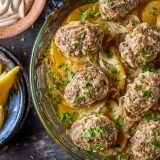King Faysal Square in Amman is a densely packed alley, plastic tables tucked tight to the walls on either side, clusters of diners broken up every few meters by alcoves from which the aromas of flames, flatbreads and innumerable roasted meats emanate. Most of it belongs to Mesbah Abdul Rahman, whose family has been cooking here for more than 65 years.
Of his many offerings, the kefta bi tahini—loosely translating as meatballs with tahini—are the most alluring. Loosely being the key term. The meatballs at his Restaurant Shahrazad actually are singular, a thick patty of robustly spiced ground lamb mashed into and up the sides of an 8-inch cake pan, topped with a mound of french fries and sliced tomatoes and chilies.

Rahman assembles the pans on one side of the alley, then hands them to a cook who rushes them to the other side, sliding them into an oven best described as a raging inferno, voracious flames licking downward. After a few minutes, the pans are pulled out. And this is where it gets good. The cook douses the meat and fries with a tahini sauce cut with yogurt, garlic and lemon. Back under the flames, the tahini bubbles and caramelizes, thickening like barbecue sauce as the meat crisps.
The result is a delicious chaos of flavors and textures—meaty richness with hits of warm spices and chili heat, all tempered by the creamy, caramelized tahini sauce, which ties the whole dish together with almost smoky savory notes. No utensils needed. Just tear some flatbread, then scoop it all up.
But without that inferno of a broiler, it just wasn’t practical for cooking beyond the ovens of King Faysal Square. Luckily, Tagreed Muhtaseb, a home cook who lives nearby, offered to share the kefta bi tahini taught to her by her mother, who favored ground beef or a mixture of beef and lamb. And rather than one massive patty, she formed her meat into oblongs, which not only creates more surface area for the tahini sauce to cling and caramelize, it also speeds the cooking.
Another change: Rather than french fries—not that there’s anything wrong with that—she heaped her kefta with hunks of potatoes that both crisped and sopped up the tahini sauce during cooking. A definite improvement.
The magic, though, really is that sauce, a mixture Jordanians call their holy trinity. Tahini, yogurt and lemon. Creamy, tangy and a little sweet, it’s the perfect foil for the richness of the meat. But it’s the heating of it—in Muhtaseb’s case, just in a basic home oven—that transforms it, reducing and intensifying the flavors. Come for the kefta, but stay for the sauce.
Tahini Taste Test
A good tahini should add creamy texture and savory richness to a dish. But the difference between good and bad tahini is stark. Most supermarket brands are over-roasted and separate into a dense paste with an unpleasant aftertaste. After tasting 14 brands, our favorites were Soom, Beirut, Lebanon Valley and Sesame King (Regular Roast). All were roasted, mixed easily and had mild bitter notes. We disliked raw tahinis, which tasted pasty and grainy.







